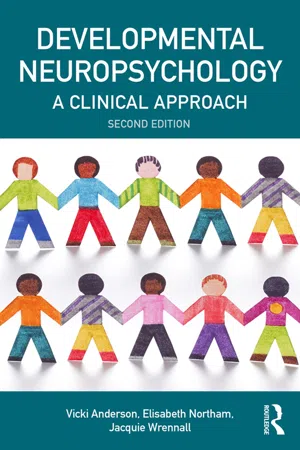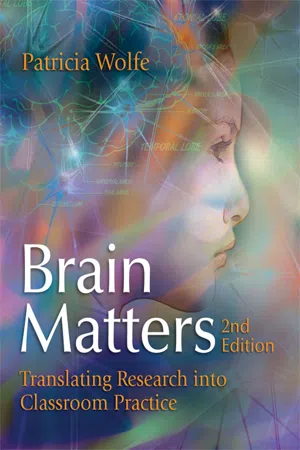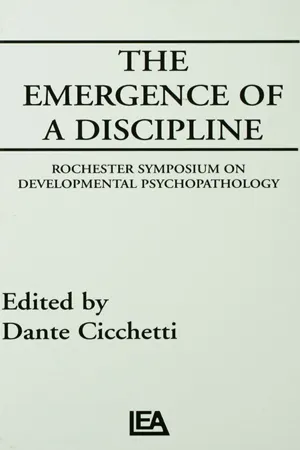Psychology
Brain Development
Brain development refers to the process through which the brain grows, forms connections, and undergoes changes over time. It encompasses the physical and cognitive changes that occur from infancy through adulthood, including the development of neural pathways, synaptic pruning, and the acquisition of cognitive skills. Factors such as genetics, environment, and experiences play crucial roles in shaping brain development.
Written by Perlego with AI-assistance
Related key terms
9 Key excerpts on "Brain Development"
- eBook - ePub
Developmental Neuropsychology
A Clinical Approach
- Vicki Anderson, Elisabeth Northam, Jacquie Wrennall(Authors)
- 2018(Publication Date)
- Routledge(Publisher)
Figure 1.3 . In order to achieve this, we need to build robust cross-discipline collaborations, which will lead to combined knowledge, which can then be translated into ‘best’ practice in the field to enhance optimal outcomes for individual children and for the benefit of the community.Brain: the ‘bio’ dimensionFigure 1.3 A biopsychosocial framework for understanding child development (courtesy of J. Delio)Source: J. Delio, personal communicationThe brain can be identified quite early in gestation, with rapid development ongoing through infancy and childhood. In the prenatal period, development is largely concerned with structural formation, establishing the basic ‘hardware’ of the brain. Interruptions to Brain Development during this period have been shown to result primarily in structural abnormalities (e.g., dysplasia, neural tube defects, agenesis of the corpus callosum). In contrast, postnatal development is largely directed towards elaboration of the brain, establishing the connectivity vital for the system to function effectively. This process of elaboration continues into early adolescence, with the primary processes including dendritisation, synaptogenesis and myelination. It is generally thought that development occurs in a hierarchical manner, with anterior regions the last to reach maturity, in late puberty. While some controversy remains, there is support for a step-wise model of Brain Development, rather than a gradual or linear progression, with convergent evidence from both animal and human research that growth spurts occur in early infancy, again around 7–10 years of age, with a final spurt during early adolescence (Gogtay et al., 2004; Paus, 2005; Thompson, Giedd, Woods, MacDonald et al., 2000; Toga, Thompson, & Sowell, 2006). A number of influences can impact on these developmental processes, including direct brain injury or insult, infection, or a variety of environmental factors such as malnutrition, trauma (e.g., neglect, abuse) or environmental toxins (e.g., lead, radiation). - eBook - ePub
- Thomas Keenan, Subhadra Evans, Kevin Crowley(Authors)
- 2016(Publication Date)
- SAGE Publications Ltd(Publisher)
developmental cognitive neuroscience is possible when we understand how the brain develops all the way from infancy, through to childhood, adolescence and even adulthood. As we will find out, Brain Development is an ongoing process, and you may be surprised to learn that parts of your brain – particularly the prefrontal cortex – continue to mature well into adulthood. The rest of this chapter will be devoted to exploring and understanding how the brain changes across development. And it does so in some unexpected ways.Before we continue, it is necessary to note that despite being vulnerable and sensitive in some ways, the brain and indeed much of our development are characterized by a good deal of resilience to internal and external threat. Although there are some ways in which we can foster and support brain maturation in children, for the most part as long as there are no major threats (such as abuse, neglect or a severe underlying genetic disorder; see Research Example 5.2 ), most brains will develop in just the right way to ensure we are able to learn and adapt to the needs of our environment. We mention this because there are a great many myths and sources of anxiety that have developed along with this area of research. For example, the idea that a certain television programme or toy can increase intelligence in babies has sparked the development of expensive products with little real benefit that are marketed to unsuspecting parents and childhood educators, who can be easy prey in their motivation to do what’s best for the children in their care (Twardosz, 2012; Zambo, 2008). In this chapter, we will also explore some of the facts and fictitious notions surrounding what supports and harms brain growth across development.There are at least three views to understanding how brain changes interact with behavioural development. Johnson (2005) identifies these as the processes of maturation, skill learning and interactive specialization - eBook - ePub
Child and Adolescent Psychology
Typical and Atypical Development
- Stephen von Tetzchner(Author)
- 2018(Publication Date)
- Routledge(Publisher)
7 Brain DevelopmentThe brain is the central organ responsible for human mental prowess, and its structure and large size relative to body size are defining features of Homo sapiens (Neubauer and Hublin, 2012). Ever since the birth of developmental psychology, an important goal has been to understand how the brain performs various functions and why it develops as it does (Preyer, 1882). There is a search for neurological processes that correspond with the various theoretical views on cognitive, social and emotional functions (e.g., Adolphs, 2009; Becker, 2006; Mahy et al., 2014; Meissner, 2008). Cultural differences are to some extent viewed in the context of Brain Development as well (Chiao et al., 2010). New technologies have led to an increasing use of brain function measurements in studies of both typical and atypical development (see Mareschal et al., 2007a,b; Nelson et al., 2006b). The understanding of brain structure and function and their development – and of the relationship between brain and mind – remains fairly limited, however (Miller, 2010). It is not likely that the human mind and the human brain are organized in the same way (Dekker and Karmiloff-Smith, 2011; Thomas et al., 2013). The basis for mapping the brain’s functions is provided by psychological models that tell researchers what to look for.METHODS OF STUDYING THE BRAIN
In order to find out how the brain is built up and performs various tasks, researchers investigate the brain of children who develop normally, search for the causes of attention deficit disorder, intellectual disability, autism spectrum disorder and other severe developmental disorders, and examine the functional consequences of cerebral hemorrhage and other physical damage in the brain of people who previously have functioned normally (Dennis and Thompson, 2013). Many studies have aimed to find out which parts of the brain and neural networks are involved in performing various mental functions. The most important methods are electroencephalography and magnetic resonance imaging, which make it possible to examine the brain while the subject performs various mental tasks (Brown and Jernigan, 2012; Hunt and Thomas, 2008). - eBook - ePub
Brain Matters
Translating Research into Classroom Practice
- Patricia Wolfe(Author)
- 2010(Publication Date)
- ASCD(Publisher)
Part 2 Brain Development from Birth Through Adolescence The brain is not only shaped by its inherited genetic code, but it is heavily influenced and shaped by its environment. If we were born with our brains completely developed, the study of human behavior would be much simpler. The growth of the body is relatively easy to observe; the growth of the brain is not. Until recently, we could only surmise what was going on in the brain by observing behavior, which led to many misconceptions. It was once believed that a baby's brain was a blank slate, a "tabula rasa," waiting and ready for instructions to be written. We now know that the truth is much more complex. Adolescent brains were once believed to be the same as their adult counterparts. This also is not true. Adolescent brains—as we shall see—do not reach adult functioning levels until perhaps their early 20s. In order to provide the best environment for the early years and to design appropriate instruction for children and adolescents during the years of formal schooling, we need to have a better understanding of the structure and function of the brain at the various stages of development. As we look at the developing brain, one of the most important concepts to understand is that of neuroplasticity. Simply stated, neuro plasticity means that the brain is shaped not only by its inherited genetic code but also by its environment. No other organ in the human body can boast this feat to the same degree. In his book The Synaptic Self, Joseph LeDoux sums this up well: "People don't come preassembled but are glued together by life. We all have a different set of genes and a different set of experiences" (2003, p. 3). For example, we know that the human brain is "programmed" at birth to hear—and eventually produce—the discrete sounds (phonemes) that constitute language - eBook - ePub
The Emergence of A Discipline
Rochester Symposium on Developmental Psychopathology, Volume 1
- Dante Cicchetti(Author)
- 2013(Publication Date)
- Psychology Press(Publisher)
4 Neural and Psychological Maturation in a Social ContextDon M. TuckerUniversity of OregonINTRODUCTIONThis chapter outlines a theoretical approach to emotional and social development that considers mechanisms of neural development and that emphasizes the role of emotions in organizing behavior. The complexities of Brain Development or social development are enough to cause a treatment of either one to be a major challenge. This chapter can be seen as a conceptual exercise. In it, I consider the implications of the evidence on Brain Development for an organismic approach to developmental psychopathology. I also suggest that the major issues of early social and emotional development frame the context for an understanding of brain maturation.PRINCIPLES OF NEURAL DEVELOPMENTFor developmental theorists such as Freud and Werner, their knowledge of a course of biological development guided their approach to understanding psychological development (Cicchetti, in press). More sophisticated and mature psychological structures were to be understood through their emergence from more primitive forms. Similarly, for Piaget, the origins of intelligence were to be found in the more elementary biological substrates of sensory and motor complexes. There are several principles of Brain Development that can inform a model of social and emotional development. Some of these are well known, and obvious enough that it may not seem important to stress them. Other principles are of more recent origin, and are only beginning to be understood in terms of their possible psychological significance.Perhaps the most remarkable thing we have discovered about biological development is that is recapitulates our phylogenetic heritage. Evolution has operated on a developmental process, and the blueprint of complex organisms contains within it the traces of the historical sequence of more primitive progenitors. This must be a profound discovery, yet it has proven to be difficult to understand its implications. Many writers point out that the parallel is not an exact one, that just because in embryonic form each of us had a tail doesn’t mean that we ever took the form of lizards. Although some parents might, no psychologist would propose that children can be understood as passing through a reptilian stage. Yet the implications of embryonic transformations for understanding development are clear. More complex patterns of cellular organization are created only through a program that first assumes more primitive forms. The later structures are transformations of these more primitive forms. - eBook - ePub
Understanding Child Development
Psychological Perspectives and Applications
- Sara Meadows(Author)
- 2017(Publication Date)
- Routledge(Publisher)
Though, to begin with, nerve cell interactions are generated by activity that is intrinsic to the brain, the timing and patterning of external stimulation plays a major role in determining the precise detail of neural networks, editing, sorting and pruning connections. This creates the basis for detailed perception, elaborated representation and refined cognitive programmes, which enable mastery of experience. Development such as this goes on throughout childhood (and perhaps throughout life), with continuity between the early mechanisms of brain growth and the later mechanisms of learning from experience, with brain tissue continuing to be self-organising. Different regions of the brain reach maturity at different ages, so that a particular task may be associated with one region of the brain early in life, and later in development other regions may be implicated in the task.The cerebral cortex is a late developer. Its nerve cells are not distributed in the fully adult pattern until six months after birth, and dendritic connections are not fully mature until adolescence. Many of its features, including a degree of left–right asymmetry and possible lateralisation from this, have developed before birth, but some psychological functions (memory is a possible example) have to be carried out in ‘stop gap’ ways prior to the maturation of the brain part which serves this function in the adult brain. Some cognitive functions are run by different brain regions in the immature individual, and the mature one, without being seriously compromised. There are, however, many ‘pre-adaptations’, where brain structures seem to be in readiness for action before they are needed. Many brain regions appear to be fairly fully developed anatomically long before they come to be used for the functions they serve in a mature brain (Greenough and Black 1992; Stiles et al. 2015; Johnson 2016).Another important region of postnatal Brain Development is the growth of an insulating sheath of myelin around nerve fibres, a process which continues throughout infancy and childhood into adolescence. Myelinisation - eBook - ePub
- Anita Thapar, Daniel Pine, James F. Leckman, Stephen Scott, Margaret J. Snowling, Eric A. Taylor(Authors)
- 2015(Publication Date)
- Wiley-Blackwell(Publisher)
Chapter 9 Neurobiological perspectives on developmental psychopathologyMark H. JohnsonCentre for Brain and Cognitive Development, School of Psychology, Birkbeck College, University of London, UKIntroduction
The brain is an organ of adaptation at multiple time scales. Over evolutionary time, our brain has become adapted in various ways to construct and occupy the niche of our species. In ontogeny (individual development), our brain adapts both to the general features of our environment shared with others, and to the individual circumstances into which we are born. Further, on a scale of days and hours, we can learn and retain information of survival relevance through processes of learning and attention. On the scale of seconds and milliseconds, our neural processes adapt to current sensory input and change state or prepare motor responses. While we can marvel at the complex and dynamic processes that underlie these adaptations, it is not surprising that there are also many different ways for them to go awry.The brain is also an organ of adaptation at multiple levels of organization. Neuroscience is one of the broadest interdisciplinary fields in biology, spanning from complex molecular interactions, through intra- and intercellular processes, to the emergent computations that result from many thousands of neurons coherently oscillating in their firing patterns. In this chapter I review perspectives on human developmental psychopathology that arise from consideration of theories and evidence from developmental neurobiology. In some respects it seems obvious that the underpinning basic science of the human brain must be relevant to issues in developmental psychopathology. However, in other respects it is less clear that complex mental and behavioral problems can be understood by reducing these phenomena to cellular or neurochemical processes. In what follows we see that the consideration of the underlying neurobiology can benefit developmental psychopathology in several ways. First, assumptions and debates in developmental neurobiology often reflect those at a “higher” level of observable and as such can be informative. Second, the advent of new neuroimaging and genetic methods make a closer integration between the two fields inevitable. Third, it is possible to integrate data from multiple levels of observable in nonreductionist ways that can enhance our understanding of neurocognitive development and the ways that this can go awry in development. - Tricia Johnson(Author)
- 2018(Publication Date)
- Routledge(Publisher)
(OECD 2007 p. 8)This chapter has covered the development and anatomy of the brain, neurons and neural pathways from the time of conception until birth. The rapid development and increasing complexity of the brain and its functions have been considered up to the age of ten years. Reference has also been made to the plasticity of the brain particularly during the Early Years, adolescence and into adulthood. The areas of the brain that are involved with and control emotions have been identified and information is expanded in Chapters 3 , 4 , 5 and 6 where the focus widens from normal development and natural processes to the impact of life experiences, cultures and the environment. Given that the foetus is in utero for nine months it is essential to consider the health of the Mother before and throughout pregnancy and after the birth of the baby.p.30 The importance of the health and wellbeing of the Mother during the perinatal periodReflection 4 Consider the following statements before reading this section so that the scene is set for considering a Mother’s health and wellbeing.(Blair, 2002, ‘On Track’ 21 December 2016)Early Brain Development establishes a child’s social competence, cognitive skills, emotional well-being, language, literacy skills and physical abilities, and is a marker for well-being in school and life resiliency■ What are your thoughts?■ How does this make you feel?■ How important is the health and wellbeing of the Mother?■ What do we mean by health and wellbeing?■ What is your role?As with neuroscience and Brain Development there has long been a focus on the health and wellbeing, not just of adults but also of children. In the Constitution of the World Health Organisation 1948, complete health and wellbeing is defined as:- eBook - ePub
- Jamie Ward(Author)
- 2019(Publication Date)
- Routledge(Publisher)
He regarded development as a cyclical process of interactions between the child and his or her environment (Figure 6.1). In his view, the genetic contribution consists of developing a brain that is readied to learn in certain ways, but progression through the stages involves assimilating evidence from the environment and then developing new mechanisms in light of the feedback obtained. While many of Piaget’s experimental studies have not stood the test of time (e.g., children show evidence of reasoning long before Piaget suggested they should), his basic approach to development has been more enduring. Figure 6.1: In Piaget's sensorimotor stage (0–2 years), a child learns about the nature of objects (e.g., that they still exist when hidden) and about the nature of cause and effect (e.g., that actions have consequences on the objects around). The child then passes through other stages (preoperational, concrete and formal operational) with greater degrees of abstraction. Although the stages can be regarded as fixed and predetermined, Piaget stressed the role of the environment to successfully develop the cognitive processes required for the next stage. © Brooke Fasani/Corbis. Following on from the developmental psychology tradition, developmental cognitive neuroscience has focused on brain-based explanations of developmental change (Johnson, 2005). One particular current approach is termed neuroconstructivism (Westermann et al., 2007). Like Piaget’s approach, this assumes constant interaction between environment and genetic factors, with a mature cognitive system emerging out of transformations of earlier ones
Learn about this page
Index pages curate the most relevant extracts from our library of academic textbooks. They’ve been created using an in-house natural language model (NLM), each adding context and meaning to key research topics.








